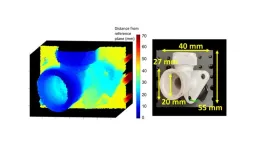(Press-News.org) FOR IMMEDIATE RELEASE
Contact:
Jillian McKoy, jpmckoy@bu.edu
Michael Saunders, msaunder@bu.edu
##
Although national COVID mortality disparities declined in 2021, this decrease was largely explained by increases in mortality among White individuals and the shifting geography of the pandemic from urban to rural areas rather than decreases in mortality among non-Hispanic Black and Hispanic individuals.
The racial disparities in COVID-19 deaths became a defining part of the first year of the pandemic in the United States, prompting national efforts to reduce this disproportionate toll among Black and Hispanic communities through vaccination drives and other outreach when COVID vaccines became available in 2021. Following these efforts, federal officials and the media touted major reductions in disparities in COVID mortality rates during the Delta and Omicron waves in the second year of the pandemic, but a new study led by Boston University School of Public Health (BUSPH) shows that the declines in these disparities do not reflect substantial improvements in population health to the extent previously thought.
Published in the journal JAMA Network Open, the study found that disparities in US COVID death rates between Black and White adults narrowed substantially from the first to the second year of the pandemic, from 339 deaths to 45 deaths per 100,000 people in 2021, after accounting for age. But this sharp decline mostly resulted from an increase in COVID deaths among White people, as well as a geographical shift in mortality from large, urban cities to rural and smaller metropolitan areas, rather than from decreases in deaths among the Black population.
Similarly, Hispanic-White disparities in deaths shrunk from 172 deaths to 12 deaths, and this decline was entirely due to increases in COVID deaths among White and rural populations.
Furthermore, while the findings showed that national COVID death rates for Black, Hispanic, and Asian populations did decrease by 2021, the death rates among these groups increased in rural areas in 2021 and exceeded White death rates.
This geographical shift in US COVID mortality and continued high death rates among racial and ethnic minority populations suggest that declarations of COVID-related racial equity achievements may be coming too soon. As the Biden administration prepares to lift the COVID public health emergency on May 11, much more work still needs to be done to address this burden among all populations.
“Contrary to popular media narratives, our findings indicate that decreases in racial and ethnic disparities in COVID were mostly explained by increases in mortality for White adults and changes in pandemic geography rather than decreases in Black and Hispanic mortality,” says study corresponding author Dr. Andrew Stokes, assistant professor of global health at BUSPH. “This suggests that it may be premature to celebrate reductions in disparities because they did not largely represent reductions in mortality.”
For the study, Dr. Stokes and colleagues utilized national data to examine COVID-related deaths among nearly one million US adults 25 and older from the initial wave of the pandemic in March 2020 to the Delta and Omicron waves through February 2022. The team examined these deaths by race and ethnicity across metropolitan and nonmetropolitan areas and developed an innovative mathematical framework to identify the factors contributing to the decline in disparities.
Through this framework, the researchers estimated that the rise in COVID deaths in rural areas—which increased from five percent of all rural deaths in 2020 to about 22 percent of all rural deaths by March 2022—and the increase in mortality among the White population explained about 60 percent of the decline in disparities, and the remainder was due to the national decline in deaths among the Black population.
The team also observed concerning trends among the American Indian/Alaska Native (AIAN) population. COVID deaths for this group appeared to increase at the national level during the Delta and Omicron waves, in both urban and rural areas.
Several social, political, geographical, and structural factors may contribute to these shifts in COVID mortality rates. Vaccination and booster rates play a central role—the researchers say the politicized nature of vaccines likely led to lower uptake of the primary series among White and rural people, and Black, Hispanic, and AIAN people have received substantially fewer boosters than White people. Rural residents also experience greater rates of chronic diseases, a risk factor for severe COVID infection, as well as greater difficulty accessing care.
“The social and structural determinants of health that have contributed to the racial and ethnic disparities in mortality observed during the pandemic remain largely unaddressed,” says study first author Dielle Lundberg, research assistant at BUSPH and doctoral student at the University of Washington School of Public Health. “Ongoing work to address these determinants of health, along with increased efforts to ensure booster uptake in rural communities, especially among older adults, are still urgently needed.”
The researchers also urge community investments and policy changes that will remove social and economic barriers largely driven by structural racism, increase access to community resources, and close the racial health equity gap.
"These results underscore COVID's ongoing toll, even in the vaccinated era,” says study co-author Dr. Elizabeth Wrigley-Field, assistant professor of sociology at the University of Minnesota College of Liberal Arts. “Full protection can't rest only on vaccination or other choices that individuals can make -- it also means social policies like paid sick leave, new standards for indoor air quality in workplaces and schools, and expanding and diversifying the healthcare workforce, especially in rural areas."
The research team included additional researchers from BUSPH, Boston University College of Arts & Sciences, Boston University Center for Antiracist Research, The University of Pennsylvania, University of California, San Francisco and Santa Cruz; Stanford University, Massachusetts Institute of Technology, and The Robert Wood Johnson Foundation.
**
About Boston University School of Public Health
Founded in 1976, Boston University School of Public Health is one of the top five ranked private schools of public health in the world. It offers master's- and doctoral-level education in public health. The faculty in six departments conduct policy-changing public health research around the world, with the mission of improving the health of populations—especially the disadvantaged, underserved, and vulnerable—locally and globally.
END
Declines in racial disparities in COVID mortality in 2021 were largely driven by increases in white mortality and changing pandemic geography
Although national COVID mortality disparities declined in 2021, this decrease was largely explained by increases in mortality among White individuals and the shifting geography of the pandemic from urban to rural areas
2023-05-04
ELSE PRESS RELEASES FROM THIS DATE:
Swaddles, hugs > withdrawal drugs
2023-05-04
Hugging and swaddling opioid-exposed newborns can reduce their hospital stays by almost a week, compared to older, drug-based methods, according to new research published by University of New Mexico researchers.
For years, clinicians have known that babies exposed to opioids in the womb were at risk of developing neonatal opioid withdrawal syndrome (NOWS), distressing them to the point of excessive crying, tremors and, in severe cases, even seizures.
Hospitals have used widely different approaches to care and, until now, the understanding of long-term consequences of administering opioid-withdrawal medications to infants has been limited.
“These findings will be ...
Lurie Children’s Hospital first in Illinois to be designated as a Rare Disease Center of Excellence by National Organization for Rare Disorders (NORD)
2023-05-04
Ann & Robert H. Lurie Children’s Hospital of Chicago is the first in Illinois to receive designation as a NORD Rare Disease Center of Excellence, becoming one of 40 U.S. academic medical centers selected to be a part of the first-of-it-kind national network of U.S. medical institutions dedicated to diagnosing, treating, and researching all rare diseases. The network is led by the National Organization for Rare Disorders (NORD) and is designed to foster knowledge sharing between rare disease experts across the country to help meet the unmet needs of more than 25 million ...
Quantum lidar prototype acquires real-time 3D images while fully submerged underwater
2023-05-04
WASHINGTON — For the first time, researchers have demonstrated a prototype lidar system that uses quantum detection technology to acquire 3D images while submerged underwater. The high sensitivity of this system could allow it to capture detailed information even in extremely low-light conditions found underwater.
“This technology could be useful for a wide range of applications,” said research team member Aurora Maccarone, a Royal Academy of Engineering research fellow from Heriot-Watt University in the United Kingdom. “For example, it could be used to inspect underwater installations, such as underwater wind farm cables and the submerged ...
American Geriatrics Society welcomes Donna M. Fick, PhD, GCNS-BC, AGSF, FGSA, FAAN As New President At 2023 Annual Scientific Meeting
2023-05-04
New York (May 3, 2022) — Donna M. Fick, PhD, GCNS-BC, AGSF, FGSA, FAAN will step into the role of President of the American Geriatrics Society (AGS) at the 2023 AGS Annual Scientific meeting which is taking place May 4-6, 2023 (pre-conference day is May 3). An AGS member since 1999 and a member of its Board since 2015, Dr. Fick is committed to working with AGS leaders and members to improve the health, independence, and quality of life of all older people.
“I have always appreciated AGS’ focus, support and advancement of an interprofessional team approach that puts older adults and caregivers at the center, embraces the best evidence ...
Investment in Ontario drug discovery research will help develop new cancer medicines for patients
2023-05-04
May 4, 2023, TORONTO – Ontario research teams investigating new ways to treat cancer are taking the crucial next steps to bring their discoveries to patients thanks to support from the Ontario Institute for Cancer Research (OICR).
OICR announced it is funding five Ontario-based drug discovery projects between $150,000 and $300,000 per project through its Cancer Therapeutics Innovation Pipeline (CTIP) initiative. CTIP supports research into promising molecules that could become the next generation of cancer therapeutics.
This year’s cohort of CTIP projects aims to develop treatments for some of the most devastating cancers, including pancreatic cancer, ovarian cancer, breast cancer ...
Machine learning can support urban planning for energy use
2023-05-04
As Philadelphia strives to meet greenhouse gas emissions goals established in its 2050 Plan, a better understanding of how zoning can play a role in managing building energy use could set the city up for success. Researchers in Drexel University’s College of Engineering are hoping a machine learning model they’ve developed can support these efforts by helping to predict how energy consumption will change as neighborhoods evolve.
In 2017, the city set a goal of becoming carbon neutral by 2050, led in large part by a reduction in greenhouse gas emissions from building energy use – which ...
University of Toronto researchers use generative AI to design novel proteins
2023-05-04
Researchers at the University of Toronto have developed an artificial intelligence system that can create proteins not found in nature using generative diffusion, the same technology behind popular image-creation platforms such as DALL-E and Midjourney.
The system will help advance the field of generative biology, which promises to speed drug development by making the design and testing of entirely new therapeutic proteins more efficient and flexible.
“Our model learns from image representations to generate fully new proteins, at a very high rate,” says Philip ...
St. Jude tool gets more out of multi-omics data
2023-05-04
(MEMPHIS, Tenn. – May 04, 2023) Despite the astounding advances made in understanding the biologic underpinnings of cancer, many cancers are missing obvious genetic drivers. When scientists can’t pinpoint the factors that drive cancer, treating it can be much more difficult. Scientists at St. Jude Children’s Research Hospital hope to solve that problem with an updated way to analyze multi-omic (primarily transcriptomics and proteomics) data. The researchers created a next-generation computational tool to gain new insights from biological data ...
Alternative fuel for string-shaped motors in cells
2023-05-04
Cells have a fascinating feature to neatly organize their interior by using tiny protein machines called molecular motors that generate directed movements. Most of them use a common type of fuel, a kind of chemical energy, called ATP to operate. Now researchers from the Max Planck Institute of Molecular Cell Biology and Genetics (MPI-CBG), the Cluster of Excellence Physics of Life (PoL) and the Biotechnology Center (BIOTEC) of the TU Dresden in Dresden, Germany, and the National Centre for Biological Sciences (NCBS) in Bangalore, India, discovered a novel molecular system that uses an alternative chemical energy and employs a novel mechanism ...
How seaweed has been misleading scientists about reef health
2023-05-04
For decades, scientists have looked to seaweed as an indicator of the health of coral reefs lying underneath.
But what if the seaweed was misleading them?
New UBC research reveals it was, and scientists need new ways to determine whether human activity is harming a particular reef.
"This is especially critical today, given that reefs globally are threatened by climate-driven stressors,” said Dr. Sara Cannon, a postdoctoral fellow at the UBC Institute for the Oceans and Fisheries and the study's lead author.
Local species ...
LAST 30 PRESS RELEASES:
Making lighter work of calculating fluid and heat flow
Normalizing blood sugar can halve heart attack risk
Lowering blood sugar cuts heart attack risk in people with prediabetes
Study links genetic variants to risk of blinding eye disease in premature infants
Non-opioid ‘pain sponge’ therapy halts cartilage degeneration and relieves chronic pain
AI can pick up cultural values by mimicking how kids learn
China’s ecological redlines offer fast track to 30 x 30 global conservation goal
Invisible indoor threats: emerging household contaminants and their growing risks to human health
Adding antibody treatment to chemo boosts outcomes for children with rare cancer
Germline pathogenic variants among women without a history of breast cancer
Tanning beds triple melanoma risk, potentially causing broad DNA damage
Unique bond identified as key to viral infection speed
Indoor tanning makes youthful skin much older on a genetic level
Mouse model sheds new light on the causes and potential solutions to human GI problems linked to muscular dystrophy
The Journal of Nuclear Medicine ahead-of-print tip sheet: December 12, 2025
Smarter tools for peering into the microscopic world
Applications open for funding to conduct research in the Kinsey Institute archives
Global measure underestimates the severity of food insecurity
Child survivors of critical illness are missing out on timely follow up care
Risk-based vs annual breast cancer screening / the WISDOM randomized clinical trial
University of Toronto launches Electric Vehicle Innovation Ontario to accelerate advanced EV technologies and build Canada’s innovation advantage
Early relapse predicts poor outcomes in aggressive blood cancer
American College of Lifestyle Medicine applauds two CMS models aligned with lifestyle medicine practice and reimbursement
Clinical trial finds cannabis use not a barrier to quitting nicotine vaping
Supplemental nutrition assistance program policies and food insecurity
Switching immune cells to “night mode” could limit damage after a heart attack, study suggests
URI-based Global RIghts Project report spotlights continued troubling trends in worldwide inhumane treatment
Neutrophils are less aggressive at night, explaining why nighttime heart attacks cause less damage than daytime events
Menopausal hormone therapy may not pose breast cancer risk for women with BRCA mutations
Mobile health tool may improve quality of life for adolescent and young adult breast cancer survivors
[Press-News.org] Declines in racial disparities in COVID mortality in 2021 were largely driven by increases in white mortality and changing pandemic geographyAlthough national COVID mortality disparities declined in 2021, this decrease was largely explained by increases in mortality among White individuals and the shifting geography of the pandemic from urban to rural areas



